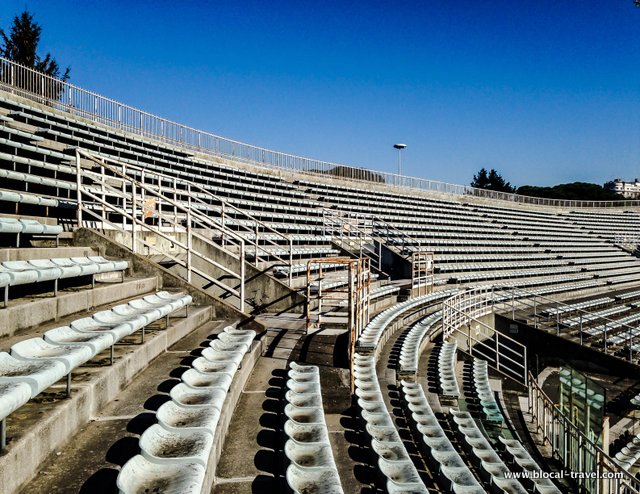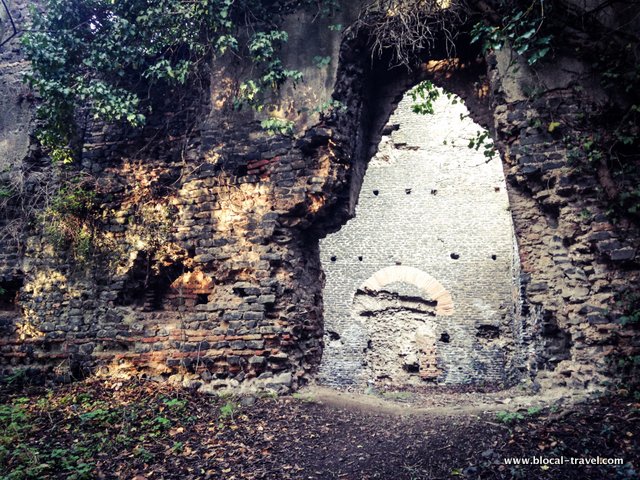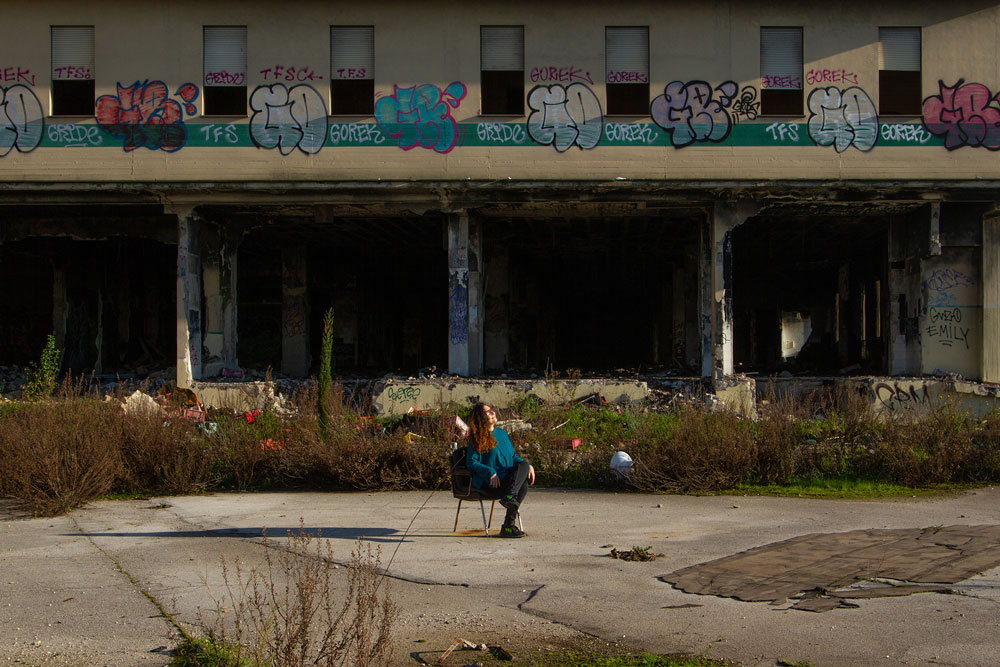
Finally my post about urbex in Rome! There is this thing with visiting places that are in your town: procrastination. It’s like the paradox of arriving late if you live close-by. I’ve simply begun accepting it, looking to enjoy some local explorations and keep the focus on a place that I thought I knew rather well. And so, here are four long-put-off urban explorations in Rome –and another similar post is coming soon. How soon, we’ll see.
Article updated in 2023.
Urbex in Rome: The Flaminio Stadium
In one of the poshest areas in Rome, the decay is hidden behind high fences and luxuriant trees. What had been a place crowded with 30,000 people is now empty and long neglected.



The once brightly-coloured Olympic circles are now faded, weathered and covered with plants, as is the pitch where balls would get lost in the bushes. The Flaminio Stadium was abandoned not long ago: the last match took place in 2011.


Built in 1959 to host the football matches during the Rome Olympics, from the 1970s it was used for rugby. The Flaminio stadium was designed by Antonio Nervi and his father, the renowned architect Pier Luigi Nervi, which makes it a building of special value from the cultural and architectural point of view, so there are architectonic restrictions on any structural renovations, making further adaptions impossible.



In addition to the pitch, the stadium also hosted a swimming pool and five gyms for boxing, gymnastics and athletics, all located under the massive stands in raw concrete.


Unlike other abandoned places, the Flaminio Stadium is in the city centre, just a short walk away from Piazza del Popolo (GPS coordinates: 41°55′37″N, 12°28′20″E). The ‘entrance’ is off Viale Tiziano, through a hole in the fence on a dead-end lane.


Street Art inside abandoned places: The Industrie Chimiche Farmaceutiche LEO
I’ve been to this place several times, and I usually come out a bit disappointed exploration-wise, as its buildings are more vandalized each time and the main construction, the one you can see from the road, is now just a raw-concrete skeleton.



Yet, this abandoned pharmaceutical factory is worth visiting every once in a while, since this is where local street artists and graffiti writers go to ‘practice’, so you can always stumble upon new pieces or even some artists at work (most of the street art can be found in the building on the left side of the first courtyard).



The LEO pharmaceutical factory began producing penicillin in 1950. It was the biggest and most-advanced penicillin factory in Europe, even according to Sir Alexander Fleming –the inventor of penicillin- who attended the opening ceremony.




The pharmaceutical factory had more than 500 workers, but more than half of them had already been fired by 1964, as the factory lost markets. It was downsized in the 1990s and then closed for good in 2008.



This abandoned pharmaceutical factory is at the intersection between Via Tiburtina and Via del Casale di San Basilio (GPS coordinates: 41.931587°N 12.583058°E). Along Via Tiburtina there are several spots where the fence is broken. As many homeless people live inside the factory, access is very easy.
[UPDATE 2018: This place has just been evicted, not sure for how long it will still be accessible… take care]
Urbex in Rome: The Calatrava’s Stadium
This never-born sports centre of sinuous architectural curves was designed for the 2009 World Aquatics Championships by renowned architect Santiago Calatrava.

The original project imagined two white ‘sails’ in steel, of which only one has been erected. Under one sail there would have been a swimming pool, while under the other there would have been basketball and volleyball courts.


The construction began in 2005 but, as the cost of the work quickly increased from the original 60 million to an estimated 600 million euros, the construction of the wannabe sports centre stopped: the aquatics championships took place at Coni – Foro Italico and this brand new, never-used complex is already decayed and long neglected.



The structure is airy and futuristic, typified by the white skeleton that always characterizes Calatrava’s works. That, and the common sad destiny of Calatrava’s highly expensive works that are often quickly abandoned or –anyway- not especially functional.



This sports centre is a landmark of south-eastern Rome: it’s very easy to spot (anyway the GPS coordinates are: 41.842585 N, 12.637282 E), but less easy to access. You will find a gate that is apparently closed at the end of Via Michele Pantanella: walk through the container park as far as the surrounding fence and you will see a spot where you can easily crawl under the fence. Beware that the stadium is under surveillance!
Abandoned Rome: The Rugby City in Spinaceto
A similar story is that of the “City of Rugby” in Spinaceto, in the western outskirts of Rome (EUR neighborhood). The project itself costed us more than 30 millions of euros, and yet the stadium has never been used.
The City of Rugby was designed in 1995; it included a rugby stadium, a guest house, swimming pools, an ice stadium, a sauna, and more facilities. Yet the rugby stadium, which was meant to be one of the premiere attractions of a ‘Rugby City,’ was built well below international standards to avoid the destruction of secular pines— the stadium is too short to meet technical requirements.

The shortened field would have prevented rugby matches from being held at the stadium; as a result, in 2015, when the city of rugby was complete but empty of people, the stadium was never called into action and the whole sports complex has been neglected ever since.

Today, the City of Rugby remains a skeleton, albeit not deserted: there are people living inside and the swimming pool area is a popular Hall of Fame frequented by Rome’s graffiti writers.
Address: Via Augusto Renzini.
Abandoned places near Rome
Ghost Town near Rome: Galeria Antica
Built on a cliff over the River Arrone, the Ancient Galeria was founded by the Etruscans, as witnessed by the Etruscan necropolis in the area.

It was inhabited by the Ancient Romans, abandoned during the Germanic invasions and then repopulated during the Middle Ages, when it grew into a fortified hamlet whose economy was based on agriculture.


It was abandoned once again after the Saracen invasions and rebuilt by the Orsini family during the 13th century. It was abandoned for good in 1809 after the malaria epidemic. Since then, nature has been taking back its spaces and the ruins of the castle and the Church of San Nicola have been covered with different kinds of plants.

In fact, since it was abandoned two centuries ago, this ghost town has become home to a unique and quite interesting ecosystem inhabited by different wild animals. As its medieval structure is still pretty intact, the village has been used to shoot several movies, although it is quite dangerous to wander around it since the vegetation covers deep holes in the ground.

The ghost town of Ancient Galeria is now a natural park in the municipality of Rome, located off the road leading to Bracciano Lake (GPS coordinates: 42.024782°N, 12.299817°E).

On the way to the ghost town of Galeria Antica I stumbled upon an abandoned farm with a striking statue of the Virgin Mary in the main courtyard. The place is made up of a few buildings, among which some silos and a big warehouse.

Abandoned Factory near Rome
I’ve been promising a new article on abandoned factories near Rome since months! Let me make up for my procrastination in this paragraph, by unveiling the GPS locations of three abandoned places near the beach:
- Ex-Tacconi Laterizi (Torvaianica) GPS: 41.64637, 12.47584
- Salumificio Cecconi (Ardea) GPS: 41.64486, 12.54201
- Abandoned Swimming Pool (Santa Marinella) GPS: 42.04502, 11.82649

Find these (and many more!) abandoned places in my Rome google map!




